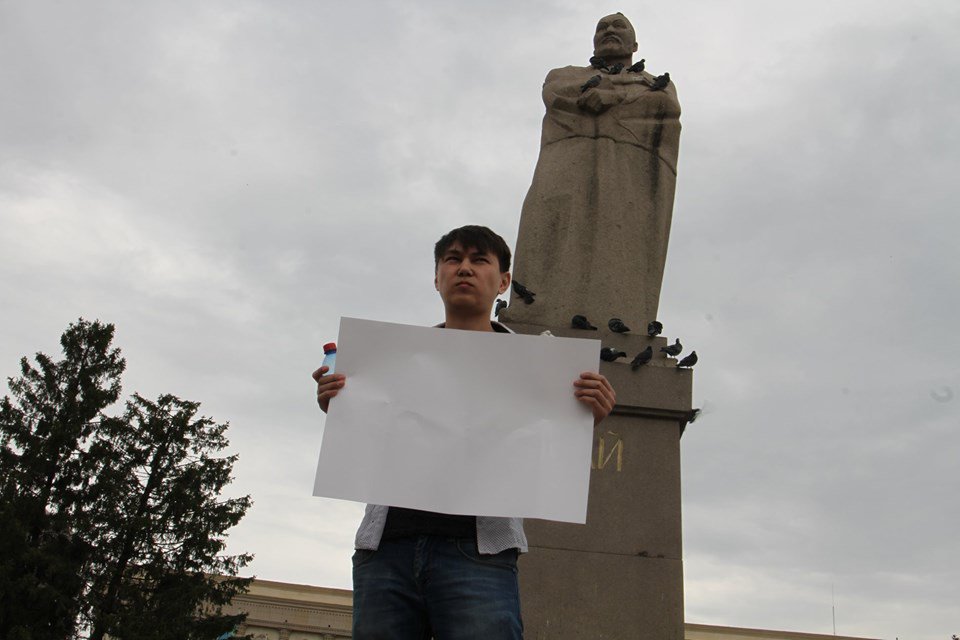Signalling signalhood as a means of protest
A few days ago Kazakh police detained a young man holding a poster in Abay Square in Oral, Western Kazakhstan. The poster, however, was blank, and Aslan Sagutdinov was later released without charged. Apparently the authorities could not agree what to charge him with. It’s like this old Soviet joke. A policeman approaches and detains a man handing out leaflets in Red Square. Looking at the leaflets he finds them blank. “Why are they blank?”, he asks. “Why write anything?”, says the man. “Everyone understands.”

During my PhD I published a paper with Simon Kirby and Graham Ritchie in which players in an interactive computer game had to find some way to communicate with one another despite no clear means by which to do so, and no pre-existing signals that could be used (Scott-Phillips et al., 2009). Exactly what was being communicated – and indeed the very fact that communication was even being attempted – had to be inferred wholly through consideration of the context in which the behaviour was observed. We did not realise that we were effectively simulating the suppression of free speech under conditions of political oppression! More recently, Tibor Tauzin and György Gergely (2018) published an experimental study showing that 13-month-old infants make contextually appropriate inferences about meaning even in these sorts of wholly minimal contexts, where the signal itself is 'contentless' but its very existence is sufficient to infer intent and hence meaning.
Strictly speaking the case of Aslan Sagutdinov is not 100% minimal. He was holding a poster of a certain size, a common means of protest, and this fact about signal form must make some contribution to interpretation, however small. So this is not quite the sort of wholly limiting case that can be artificially induced in laboratory conditions. It is nevertheless close, and indeed the fact that the police saw fit to detain him despite his sign containing no actual words of protest is indeed evidence of just how effective and clear his message still was – and hence of how much potential human communicative abilities have as a means to create the common knowledge necessary for mass protest.
With thanks to Dina Baidildayeva and Simon DeDeo, who alerted me to this story. See [1] for video.
Scott-Phillips, T. C., Kirby, S., & Ritchie, G. R. S. (2009). Signalling signalhood and the emergence of communication. Cognition, 113(2), 226-233.
Tauzin, T., & Gergely, G. (2018). Communicative mind-reading in preverbal infants. Scientific Reports, 8(1), 9534.
***
[1] "Meta Protest: Kazakh Man Detained Holding Blank Poster" (video). Youtube @rfe-rl Radio Free Europe/Radio Liberty. May 7, 2019.



Christophe Heintz 17 May 2019 (08:23)
Are we not accountable for what we mean?
This story nicely illustrates how people ascribe commitment to communicators. The policemen attributed to the demonstrating man, Sagutdinov, a commitment to politically subversive propositions. He did not write down the political subversive propositions, but these propositions are, in the context, the most relevant information that can be inferred from his ostensive behaviour. Yet, the legal institution did not think that Sagutdinov could be held accountable for communicating subversive propositions. He is, in that case, thought to be in a position where he could plausibly deny having meant what everybody understood him to mean.
It is puzzling to me how legal institutions deal with plausible deniability and accountability for what is meant: there seems to be, on the one hand, the belief that intentions (esp. communicative intentions) are not observable and as such cannot be inferred without doubt. On the other hand, legal institutions do usually give important roles to intentions. For instance accidental killing differ from murder by the content of the intention of the killer. I don't think that any legal institution would promote practices that lead to qualify killing as murder only if it is done with a pre-registered weapon. Killing with a gun, it's amurder; killing with a stone, it's an accident. However, if you replace killing with communicating something you should not, and weapons with words, you obtain the judgement of the legal institutions: if it is not communicated with words, explicitely, then you might not have had the intention to communicate what you should not.
Why do we have institutions that condemn communicative actions only when the communication is done with words that signify the communicated meaning? A hypothesis: because of the spread of a false naive theory of communication, which takes it to be coding.
Hal Morris 9 June 2019 (02:36)
But does everyone understand?
It's a good basis for a joke of the Soviet era or the neo-soviet era. What I think I observe in many contexts is the remarkable facility with which people believe they all have the same understanding of something. In a simpler world, hunter-gatherer cultures with a cultural space of a few thousand people, and every Ur-tribe (as I would call the span of people speaking the same language and having more or less the same model of the world), having constructed their own way of making their present locale (whether desert, jungle, tundra, archipelago, etc.) into a solvable problem my intuition is it worked pretty well for that purpose, but is breaking down in a world where hundreds of thousands of microcultures jo
stle eachother.
In this world, in the case of many assumed shared meanings, such as "liberalism" or "conservatism", we have a very real, not speculative, version of Quine's "gavagai" problem.
The guy holding the blank sign or handing out blank pamphlets may be saying "We're all f**ked", or he may, like late 19c anarchists (the sort who killed McKinley and Tsar Alexander), have in mind the primitive plan of killing the highest member of the ruling class you can manage to kill (not as easy to do as in the last 19c), or he may mean "Let's all refuse to work." The guy with the blank sign was not giving a call to action that everyone understands. He may be opinionating in a way that many people understand to a degree, but opinionating, or heaping adjectives on the heads of the rulers, is easily kept in check by a clever modern state. So he was released because the gov't probably reasonably decided he wan't doing anything threatening.
A more interesting case: Gene Sharp, the theoretician of "Color revolutions" (see www.aeinstein.org) showed how a group of like-minded people could communicate a coordinating signal among themselves, and an assessment of their own strength by wearing a certain color or a certain flower on a certain day, or opening windows and banging pots and pans for one minute at a specifically planned moment, which truly did baffle tyrannical powers at times (he had a lot to say about how to gain momentum and too little to say about what to do next, when/if you succeed).
"Signalling Signalhood", or interpreting signals of signalhood, the miraculous thing that 13 month olds are capable of is one of the most powerful forces on the planet, and is a major cause of the "Ultrasocial Species" dominating the planet, but it's a delicate thing that needs tender nurturance to thrive, so is unlikely to be much help in ridding the world of dictatorship.